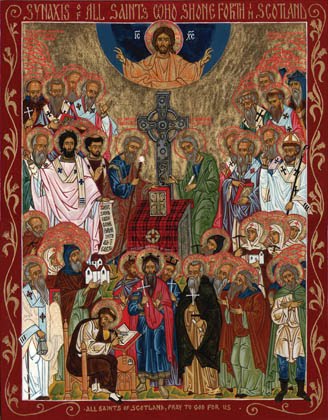OUR VENERABLE AND GOD-BEARING FATHER COLUMBA OF IONA, ENLIGHTENER OF SCOTLAND (521-597)
 Saint Columba (the Latinized name for Colum, meaning dove) was born at Garten in Donegall to a noble family. He entered the monastic school of Moville under Saint Finnian, who had studied at Saint Ninnian’s great monastery. Here Columba received the diaconate and entered monastic life. Tradition tells us that it is there that his sanctity is first attested to by the performance of miracles. Having completed his training he travelled to Leinster and then later to the monastery of Clonard. Here he was probably ordained priest before leaving for Glansnevin and the monastery there. When a pestilence devastated the country in 543, the monks dispersed and Columba spent 15 years traversing in Ireland founding several important monasteries, including Derry in 546. Sometime around 560, he became involved in a dispute with Saint Finnian over a psalter. Columba had copied a psalter and believed he had the right to keep it, Saint Finnian did not.
Saint Columba (the Latinized name for Colum, meaning dove) was born at Garten in Donegall to a noble family. He entered the monastic school of Moville under Saint Finnian, who had studied at Saint Ninnian’s great monastery. Here Columba received the diaconate and entered monastic life. Tradition tells us that it is there that his sanctity is first attested to by the performance of miracles. Having completed his training he travelled to Leinster and then later to the monastery of Clonard. Here he was probably ordained priest before leaving for Glansnevin and the monastery there. When a pestilence devastated the country in 543, the monks dispersed and Columba spent 15 years traversing in Ireland founding several important monasteries, including Derry in 546. Sometime around 560, he became involved in a dispute with Saint Finnian over a psalter. Columba had copied a psalter and believed he had the right to keep it, Saint Finnian did not.
In 563 Columba, with twelve companions, left for Scotland. The reasons given for this departure vary but it is probable that he was involved in encouraging clan warfare against King Diarmait in 561, with some connection to the psalter dispute. On the Island of Iona he founded the famous Abbey, a centre for Celtic Christianity. Iona became a base for missionary work amongst the Northern Picts. Columba visited King Bridei, near Inverness, and won his respect. The royal residence had been bolted closed but, at the sign of the cross, the doors flew open and thus struck by such a miracle, the King listened and was baptised. Many of the people soon followed. This respect he found subsequently led him into a political role and he helped greatly in shaping the political landscape of that time, with some opposition remaining from the Druids.
Columba spent the rest of his life preaching and travelling in Scotland. The ‘Book of Deer’ (a tenth century illuminated manuscript, providing a unique insight into cultural, social and ecclesiastical life of the East of Scotland.) attests to Columba’s work and miracles in the East of the country. On another journey to the West he met with Saint Mungo, the apostle of Strathclyde. He returned to Iona, when not engaged in missionary work, and there many came to seek his counsel. From here, Columba governed the many communities he had founded. In the Celtic tradition the Abbot, although perhaps only in priest’s orders, was at times considered to govern above that of the position of a bishop, the bishop thus being subject to the Abbot’s jurisdiction.
On the afternoon of 8th June, 597, Columba climbed the hill behind his monastery and gave his final blessing to the place he loved so much. At vespers, that night, he collapsed before the altar and found home with his heavenly Father, surrounded by his monks. He was seventy six years of age. He was buried in the monastery but, one hundred years later, his bones were disinterred and revered. They were taken to Ireland when the threat of Vikings became apparent but they vanished in time. Books and garments remained at Iona Abbey and were the focus for miraculous works.
Saint Adamnan, a future Abbot of Iona, said of Columba
“He was angelic in appearance, graceful in speech, holy in work”.
It is without doubt that Columba stands as one of the greatest of the Celtic Saints. A man of incredible industry, of missionary work, of creating communities and not least a man of humility and deep charity.

No comments:
Post a Comment